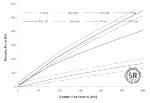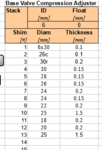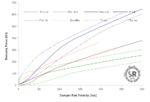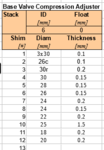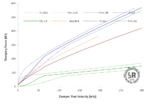Have you done anything with the rebound yet? If you soften the compression but leave the front rebound and the rear shock as-is, the front suspension will be packing up more and you may actually lose some front end traction. You may be able to regain it if you back out the front rebound clickers and let the wheel get back on the ground faster.
Rebound damping depends heavily on the spring rate, since no other forces are acting to extend the suspension. The maximum rebound velocity the fork sees will be at the point of bottoming, since the spring force at that point is the highest. Stiffer spring rates require more rebound damping to get the same feel, and softer spring rates require less rebound damping. Typically the best place to start is a rebound setting where the suspension
slightly overextends past its sag point after compression but recovers quickly after that. So the goal is to tailor a rebound damping curve for a given spring rate that
slightly overextends past sag in a majority of the terrain you encounter. As you can imagine, that depends on the type of terrain you are riding, how fast you are riding, etc. You don't want the suspension to extend so fast that it upsets the chassis, which in term transmits upward force to the rider, but you also don't want it to extend too slowly so that there isn't enough travel to soak up terrain after that.
In Physics they say that mgh = mv^2 / 2. If my calculations are correct, if you flatland a 10-foot drop, you get a 302 in/sec vertical suspension compression speed at the moment when you touch down. To get a 20 in/sec speed you only need a 0.5 inch drop, assuming an incompressible tire. Weird, I know, but this is what the math says.
I did the same exercise when trying to determine velocities, but that freefall equation only accounts for a straight vertical drop to a flat surface. Landing on a downslope from 10 feet up would produce much lower velocities than landing on a flat surface from 10 feet up.
We are objects in motion, so we have to consider the force vector. If the impact force is vectored ahead of the line perpendicular to the surface (a down slope), less net downward force is experienced. If the impact force is vectored behind the line perpendicular to the surface (IE, you case a jump really bad, or you slam into a sharp breaking bump), the impact force is greater because now lateral deceleration forces are being applied. So without having actual suspension telemetry to record the velocities encountered for your riding type, its tough to know for sure exactly what velocities your suspension is experiencing for the type of riding you are doing. Instead, we have to rely on either data that's already out there or using our best educated guess.
Here's where things get interesting. Freefall equations account for an object falling until it impacts a surface. But we can use the same concept to determine how quickly a wheel needs to "move out of the way" of a bump. If the front wheel can't move out of the way quick enough, that translates upward force to the chassis. If the fork is so soft that the wheel can move out of the way quickly, then almost 0 force (outside of momentum forces of the unsprung weight) are applied to the chassis, and you essentially plow through bumps without feeling them.
The kicker is the fork velocities when hitting a square edged bump may be identical to the fork velocities you'd see when flat landing. So a damping curve that would allow you to plow through those square edged bumps would likely be way too little to support you on an overjump, and this is precisely why there is no one shim stack configuration that rains supreme. Suspension is a compromise, and the goal would be to feel the best in "most" scenarios you encounter during your riding.
For a 21" tire, hitting a 3" square edge bump at 50mph is the same 300in/s initial velocity you'd experience at impact of a 10ft freefall to flat! With the same valving for those two scenarios, the
chassis should "feel" roughly the same in both scenarios on initial impact. You always hear in motocross how pros have super stiff suspension compared to us mortals, but it makes sense. Hitting a 3" square bump at 30mph produces roughly 2/3 the fork velocity as hitting that same 3" square edge bump at 50mph, so more damping force is needed to get the same feeling in the chassis!


